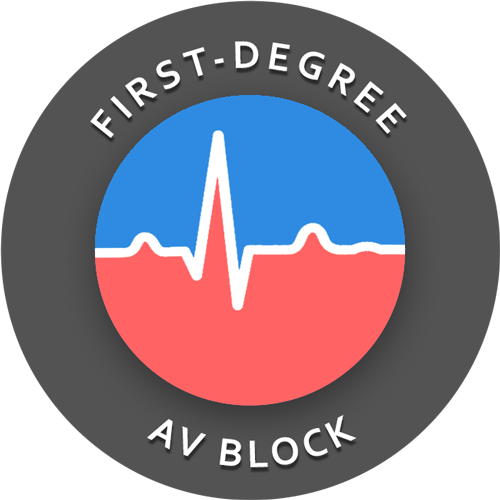
Also called first-degree AV block is a disease of the electrical conduction system of the heart in which the PR interval is lengthened beyond 0.20 seconds.
This lengthening of the PR interval is caused by a delay in the electrical impulse from the atria to the ventricles through the AV node.
Normally, and in the case of ACLS, first-degree heart block is of no consequence unless it involves myocardial infarction or an electrolyte imbalance.

Although first-degree heart block is not clinically significant for ACLS, recognition of the major AV blocks is important because treatment decisions are based on the type of block present.
There are a number of disorders that can cause first-degree AV block, but it may be a normal variant in the conduction system of the heart. Some of the most common causes are listed below:
Causes of First degree AV block:
- Increased vagal tone (well trained athlete)
- Electrolyte disturbances
- Myocarditis caused by infections
- hypoxemia (see more in infants and children)
- Cardiac surgery
- Congenital abnormalities (see more in infants and children)
- Myocardial infarction
- Medications that inhibit AV node conduction (amiodarone, beta-blockers, calcium channel blockers, digoxin)
- Acute rheumatic fever (see more in infants and children)

Below is a short video which will help you quickly identify first-degree AV block on a monitor. Please allow several seconds for the video to load. (3.40 mb)
Click for next Rhythm Review:
Second Degree Heart Block Type I
Top Questions Asked On This Page
-
Q: So would I call that sinus rhythm with a first degree AV block? Or just first degree AV block?
A: You can say it either way. They both are correct.
-
Q: What should a nurse do first if there is an abnormal ECG reading. Do you take the pulse first or go ahead and the CPR?
A: An abnormal ECG only indicates that there is an arrhythmia in the heart. You will first look at your patient. If they are awake/responsive, you will not have to check a pulse, and you would not need to perform CPR. If you find a person unresponsive, you would call for help and a defibrillator and then perform a pulse check. If there is no pulse, then begin CPR.
-
Q: You had a video on this site that helped with the basics of ECG strip analysis. Can you post that again?
A: Here is a video that will help you with the very basics of ECG strip analysis.
priya says
Its really very helpful thank you
Ramon says
Excellent tool.
Ms TIYA says
Thanks 4 d videos…………great help.
m.chandrakala says
its very helpful to rembember simple and clear thank you.
lana says
Helpful thank
Jillian says
I’ve searched several videos for easy to understand ACLS preparation information. So far, this has been the most helpful in that the use of comparison videos makes it so much easier to understand ECG strips. Being able to see them side by side to compare the differences is the easiest way to differentiate the several types of rhythms. Thank you!
Harriet says
I was chosen to be one of the candidates for ACLS in my hospital here Kingdom of Saudi Arabia, and started to find your site interesting and hoping it would help me through with my ACLS course…..Best of luck..
jesusfreak83401 says
I am a brand new ACLS student and I have had a lot of trouble with ECG strips I really like the viedo with shows NSR and AV block side by side thank you. Even after only being on for a few hours I feel more knowledgeable
Dr Raja says
Came across your website while researching for my ACLS next week.
Excellent site made simple.
Will definitely introduce to my staff in ED.
once again thank you and may more benefit from your input.
Dr Raja
cheryl1 says
I have never learned how to read an ECG strip, so I would like to start with the very basics of how to interpret a normal sinus rhythm. Is there any place on your site that shows/explains the basics, or systamatic steps of what is needed to read a normal rhythm? This would be quite helpful to know before trying to learn what is abnormal.
Jeff with admin. says
Here is a video that will help you with the very basics of ECG strip analysis:
Kind regards,
Jeff
Theresa Holland says
Hello Jeff, this video was a very good refresher. Thank you.
cheryl1 says
Thanks, you are the source, and the ACLS man!
sandra thomas says
help me with ekg’s
bevmen says
Thank you for this wonderful site. I’ve been a nurse for over 25 years, and this is the first time I will recertify with confidence and not sheer terror! Thanks to you, I now understand the rationale and the WHY, and not just mindless memorizing. I will definitely be back in 2015 with all the expected new AHA changes.
Eric says
Could you possibly put strips on the blocks like for vfib and vtach please
Jeff with admin. says
Thanks for pointing this out. It looks like the only block that did not have a rhythm strip was the first degree heart block. I will add an image to this page soon.
Kind regards,
Jeff
jrf123 says
you forgot to mention the actual number of boxes/msecs that define the upper limit of normal for pr interval
Jeff with admin. says
Thanks for pointing that out. 120-200 ms or 3 to 5 small boxes on the rhythm strip.
Kind regards,
Jeff
Dr. Roces says
Great very good tool to review strips.
sebin says
fabulous video///
vapacu2 says
excellent teaching tool